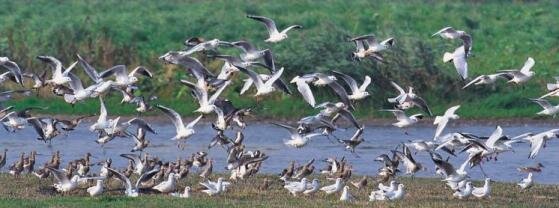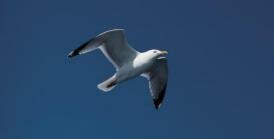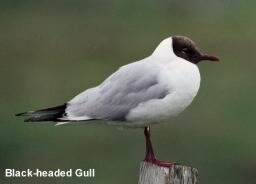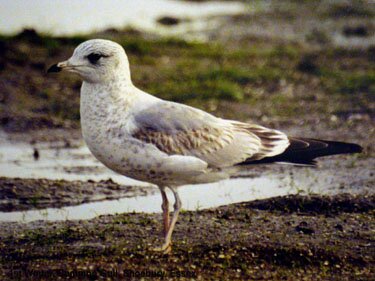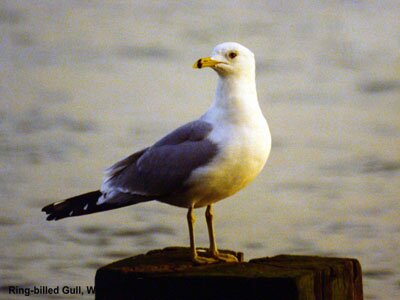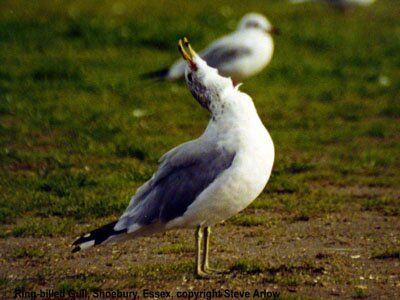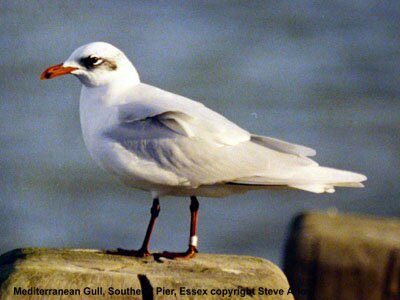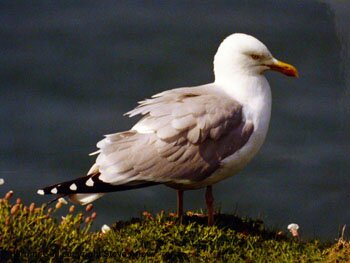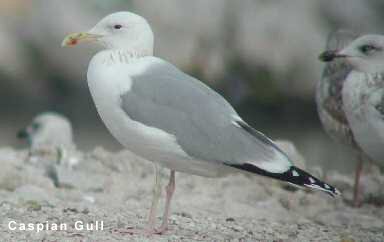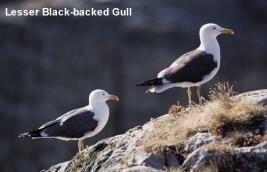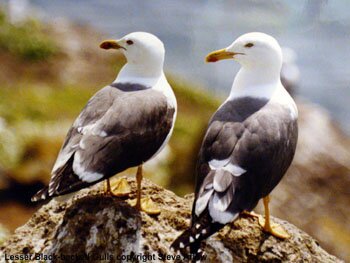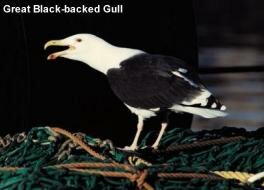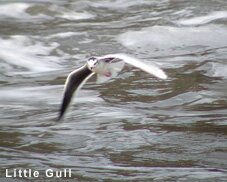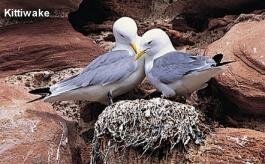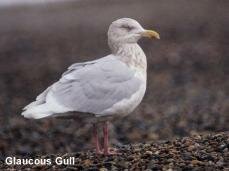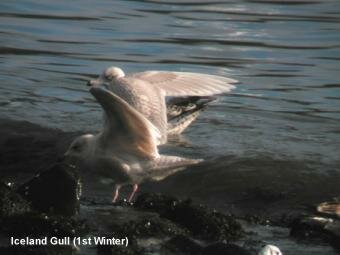Gulls are a widespread and obvious bird group in the Southend area being found in most of our birding locations with the exceptions of just a few sites. They can often gather in large numbers, sometimes in the thousands and are generally easy to observe. With the many locations where gulls gather and the huge numbers that annually winter around our shorelines this group of birds is still greatly over looked or ignored.
There could be many reasons why many local birders choose to ignore gulls. One of these reasons could be partly due to that fact that they are a highly complex group with extreme care being needed to identify certain species from another. A further reason could be 'where to begin' as there are just so many gulls to look at. Once you've seen a flock 200 Black Headed Gulls scanning another and then another may seem just a little boring.
Going through flocks of gulls, though, will sometimes bring its reward with the discovery of something different, a Mediterranean Gull for instance. It may only be a matter of time until someone finds the gull that makes it all worthwhile, a Laughing or Franklins perhaps. American gulls yes but they have occurred on a number of occasions on the East Coast in recent years, including Southend.
Even if you don't find a rarity the infinite different plumage's gulls have make gull watching fascinating.
The following are the five best gull watching locations in the Southend area.
1. Shoebury East Beach
Shoebury East Beach is amongst the best of all the sites around Southend. The best place here is at the beach's most easterly point, at the boom near the MOD fence. Gulls gather on the raised posts to roost and sit out the high tides. The best time here would be during the winter months, during the evening and on a high tide. The reason for this is that gulls from all over the area, and from even far inland, fly out in their thousands to roost overnight just at this location. They start to arrive early evening and increase in numbers during the next few hours until all the posts have a bird sitting on them it and the water in covered gulls. The high tide will keep many of the birds close to the shore whereas low tide will have them too far out to be of any real value, the tide goes out a very long way here.
High tides during the day can also be rewarding, the best time to visit would be when the tide is falling and mud starts to gets exposed as many gulls will leave the boom to feed and any gulls that had been roosting further out will join them. Mediterranean Gulls are regular winter gulls amongst the hordes but Iceland Gull and Ring Billed Gull have also been seen in the past year (2000). The fields just inland of the beach road also have substantial roosting numbers with Mediterranean Gulls being seen occasionally.
Autumn can also attract large numbers of gulls with many in mid moult just to add to the already confusing array of plumages. Mediterranean and Ring Billed Gulls have been noted in September with both being noted but also Yellow Legged Gull can be more prominent.
2. Westcliff Seafront
The seafront area directly around the Westcliff Casino has, for a few years now, been recognised as a regular Mediterranean Gull haunt. It wasn't until the discovery of the Ring Billed Gull here in March 2000 that the true picture of Mediterranean Gull numbers here became apparent. During 2000 an estimated 20 - 22 different individuals were noted as many people came to see the Ring Billed. The foreshore west of Southend Pier and west to a few hundred yards past the Rossi's Ice Cream parlour has been one of the most productive for gull sightings in Southend in recent years. The area directly opposite Rossi is especially favoured. This location, however, is tide reliant and for the best chance of seeing the Ring Billed and Mediterranean Gulls the timing must be just right. Two and half hours either side of high tide is best as mud will be just showing. The birds move to these from their roost areas to feed. As yet, the regular Ring Billed Gull has not been found roosting anywhere over the high tide period but can sometimes still be found lingering around the lampposts by Rossi.
Gulls at this location are used to being thrown bread and close views of the Ring Billed and Mediterranean Gulls can be obtained in this way. Other recent gull sightings from the stretch of coast have included a report of a 1stWinter Ring Billed on 2 dates in March 2001, a 1st Winter Iceland Gull on the posts of the tide break opposite Rossi in March 2001, a possible 2nd Winter Caspian Gull, several Yellow Legged Gulls, Kittiwake and all the usual gulls such as Black Headed, Common, Herring, Lesser Black Backed and Great Black Backed Gulls.
Gulls numbers generally are low throughout the summer with numbers start to build up from late July onwards with immature Mediterranean Gulls arriving at this time. The adult Meds start to arrive from August. The Ring Billed Gull tends to reappear from early / Mid September when it then completes its outer primary feather moult. The possibility of discovering a rare gull here is good as most birds are approachable and you can even watch them from the car if you wish.
3. Southend Pier
This has got to be the best place for Mediterranean Gull in Essex. The posts by the slip way at the Pier head around high tide always seems to have a Mediterranean Gull on them. Since the mid 1980's when the regular singleton, ' Mike the Med', was present for many years, numbers have steadily increased. Counts from September 2001 have numbered 16 birds together at any one time. There are now new regular birds that have returned for several years to please the visitors.
The Pier is more than just for Mediterranean Gulls as it has shown it can turn up all sorts of other gulls. 2000 saw a large invasion of gulls into the outer Thames estuary with in the region of 10,000+ being seen regularly from the Pier. Little Gulls have often been seen from here but the rarer gulls have also paid rewards to those hardy enough to brave the cold weather. Glaucous and Iceland Gulls have featured in winters past as did a Ring Billed Gull for a few lucky observers in the 80's.
Winter and autumn gales can bring impressive numbers of Kittiwakes to the river and many can be seen close to the end of the Pier. Strong or even a light easterly with fog on the Kent coast can result in a good day here. October 2001 saw a juvenile Sabine's Gull past.
The prize, however, must go to the lucky individual who had a superb adult Franklin's Gull fly past while it followed a trawler. Will there ever be a better or rarer bird seen from the Pier again?
4. Barling Tip
A rubbish tip. Must be a gull's idea of heaven. This particular dump can be viewed from the seawall that accessible from Barling Pits east to Potton Creek. Gulls are generally present all year round here with the non-breeding birds staying the summer. Numbers reach their peak in winter when clouds of them can be seen squabbling over anything from an old sock to a crisp packet. The amount of gulls on offer here is bewildering.
I began seriously watching this site in February 2001 just before Foot and Mouth closed down the countryside and have not been able to make any return visits. During the half dozen or so visits that I made I discovered numerous Mediterranean Gulls, several Yellow Legged Gulls from differing ages including some remarkably striking 1st Winter Yellow Legged Gulls. Also several 2nd Winter and Adult birds of this species were found. If you intend to watch the gulls here I would suggest taking a stool or foldaway chair for a little comfort. Walk along the seawall until you can actually see into the pit, as this will give you the greatest field of view over the whole tip. The sun will behind you so improving the light if it is a bright day. Strangely the gulls here are rather nervous of people walking along the seawall and they can often be put up even when you are still a long way away. This is surprising, as once a dump truck appears they clamber around just a few feet away from the trucks and the dustmen. Once the gulls had dirtied them themselves in the frenzy they often go onto Barling Creek behind you to bathe so it's worth remembering not to make yourself to obvious on the seawall.
Large flocks can also gather on the fields beyond the tip and even get onto the river Roach. To look at these will take a stealthy approach below the seawall. If you don't mind the smell and often cold wind then this could be the place to find the larger White Winged Gulls. A Glaucous Gull was found in February 2001 on the fields of Fleet Head, the other side of Barling Creek opposite the tip with a large gull flock and birds there should be investigated thoroughly also.
The tip is worked during weekdays and occasionally Saturday mornings so a trip should be planned for these times, gull numbers are much reduced when the tip is not in operation.5. Leigh / Two Tree Island / Benfleet Creek complex
This is the 'original' gull watching location in Southend, which resulted in numerous sightings of both the larger White Winged Gulls and Mediterranean Gulls and was the location of the first twitchable Ring Billed Gull in Essex.
At Leigh Cockle Sheds, best viewed from the car park beneath the flyover, gulls gather out on the mud but due to a recent change in practices at the sheds only the smaller gulls are generally found. It is still possible to find the odd good gull here.
At Two Tree Island the best gull watching site is from the end car park by the slipway. On a rising tide gulls get pushed in closer and the area is generally a good place in early autumn to watch Yellow Legged Gulls. Mediterranean Gulls are also occasionally noted.
Further west along Benfleet Creek many gulls gather on the mud and a low or falling/rising tide is best for here. Access is either from the Two Tree end, along the footpath by the Golf Driving Range or from the Benfleet end by the boatyard. The Seawall used to be a working rubbish tip but has long been closed and left to revert back to nature. Yellow Legged Gulls are fairly common here from July to September and may be present in small numbers all year. When the tip was in operation both Glaucous and Iceland Gulls were regularly seen but are far scarcer nowadays.
Other areas also worthy of mention is:
The River Roach / Barton Hall Creek/ Paglesham Lagoon complex.
Another very good place for gulls, especially the stretch from Stambridge Mills to, and including, Barton Hall Creek. Yellow Legged Gulls are regular in early autumn with a few wintering birds present. An adult Caspian Gull was seen in early January 2001. Paglesham Lagoon regularly attracts large numbers of gulls that come to bathe. Regular scanning of the flocks have resulted in a both Iceland and Glaucous Gulls, Mediterranean Gulls and Yellow Legged GullsCanvey Point / Hole Haven Creek
Canvey Point regularly gets large numbers of gulls, especially in winter, and Yellow Legged Gulls are seen every autumn. A Seawatch in a good easterly will often result in numerous Kittiwakes and in autumn Sabine's Gulls have been seen almost annually and it is possibly the premier site in Essex for this bird.Hole Haven Creek is somewhat of an unknown quantity but large numbers of gulls are known to use the creek. With its proximity to Tilbury Yellow Legged Gulls must surely occur, as could some of the other scarcer gulls. A walk north along the seawall will eventually bring you to the north side of the Pitsea Cleanaway site. Gulls from the tip often bathe in the creek. This is perhaps the most inaccessible site as it involves a walk in the region of a 5 - 6 miles round trip. A long walk if you don't see anything of note.
Pitsea / Vange
Gulls can be seen easily from the main hide at Pitsea, Wat Tyler Country Park. Mediterranean Gulls are regular, as are Yellow Legged Gulls in autumn. The gulls bathe and roost after feeding on the Pitsea Cleanaway site. Vange Marsh also attracts these birds but they can be a little less approachable. Yellow Legged, Little and Mediterranean Gulls have been seen in the past year or so. Best Access would be from either the old wood yard entrance off of the A13 or from walking from Pitsea Rail Station.Southchurch Park
The pond and playing fields to the east of Liftans Way often have a gull roost over the high tide period and it is a good place to look for Mediterranean Gulls.Inland playing fields such as Prittlewell and Westcliff High Schools and Blenheim Park
These fields will usually have a flock present in winter but they are generally only made up of Black Headed and Common Gulls and birds such as Mediterranean Gulls are often found in an association.Gunners Park and Uncle Toms Cabin
In winter the playing field in the northeast quarter floods and a gull flock usually forms during the life of the flood. Most are small gulls with the odd Mediterranean but Common Gulls can often be present in reasonable numbers while larger gulls are only part time visitors, generally coming to bathe.
Uncle Toms Cabin at nearby Shoebury Coastguards also has regular winter gull flock over the high tide period and was the site of the Ring Billed Gull of the winter of 1999/2000. Mediterranean Gulls are often found.
Black Headed Gull (Larus ridibundus)
A common and widespread gull in the Southend area and can be seen nearly everywhere in the area.
photo taken by and copyright of Steve Arlow, Southend Ornithological GroupCommon Gull (Larus canus)
Another abundant species in Southend but less common than the Black Headed Gull. It can generally be found singly or in small flocks. Substantial flocks can be found however and can even show a preference for inland playing fields.
Photos taken by and copyright of Steve Arlow, Southend Ornithological GroupRing Billed Gull (Larus delawarensis)
A very rare vagrant from North America to the Southend area with between 5 and 8 records including several long staying birds, the 2nd Winter at Leigh cockle Sheds in August 1985 for over a week with reappearance in March 1986 for a week. A 3rd Year at Shoebury Coastguards from September 1999 to April 2000 and the Adult from March to April 2000, again from September 2000 to April 2001 and then reappearing again from September 2001 to current date (27/10/01).
Photos taken by and copyright of Steve Arlow, Southend Ornithological GroupMediterranean Gull (Larus melanocephalus)
A once scarce bird has made a dramatic increase in the past couple of years of or so. Indeed so much so that over 20 were seen at Westcliff seafront and over 20 from the Pier in 2000 alone. The Pier has probably surpassed even these figures this year with 16 seen on one September day alone. Between 8 and 12 can be seen regularly over the high tide period at the Pier Head. Mediterranean Gulls can often be found in gull flocks all over the Southend area at nearly any time of year.
Herring Gull (Larus argentatus)
Two races occur but it is the Scandinavian argentatus race that is the more abundant around our shores in winter. The resident 'British' race argenteus is a common winter visitor to our area from colonies around the country and only breeds in very small numbers in Southend. Herring Gull is a common autumn and winter visitor and can be found at most coastal sites with smaller numbers inland.
Yellow Legged Gull on right, Herring Gull to left.
Photo taken by and copyright of Steve Arlow, Southend Ornithological GroupYellow Legged Gull (Larus michahellis)
Primarily an autumn visitor to the Thames and Roach estuaries with a few being found all year round. The Yellow Legged Gull in complex with as many as 4 or 5 different races that are potentially distinct species in their own right.
Photo courtesy of Menotti Passarella. Website: http://oystman.tripod.com/italiangulls/Caspian Gull (Larus cachinnans)
Caspian Gull is currently only treated as a race of Yellow Legged Gull but is placed under it's own heading as advance's in gull identification may soon bring this bird distinct species status. This gull is a close relation to Yellow Legged Gull and all plumage's are similar. Identification is less than straight forward. Currently classed as a rare vagrant to the UK but observer awareness is resulting in increased sightings. In our area there have only been two birds that probably have been Caspian Gulls, a 2nd winter at Westcliff Seafront at the end of 2000 and an adult along the Roach in January 2001.
bottom photo taken by and copyright of Steve Arlow, Southend Ornithological GroupLesser Black Backed Gull (Larus fuscus)
A common bird with a peak in numbers in autumn and spring with lesser numbers in winter but can still be found in many of the usual estuarine locations. Barling tip is probably the prime winter location for this species. The race graellsii is the most abundant race to occur while the intermedius race probably occurs more frequently in late autumn and winter. fuscus has yet to be confirmed as occurring in the UK.
Great Black Backed Gull (Larus marinus)
A common bird in autumn and winter with most along the Thames Estuary with smaller number along the Roach Estuary. This species is scarcer inland but a few may be found on the larger playing fields
Photo courtesy of Eugene Archer. Website: http://www.irishbirding.com/Little Gull (Larus minutus)
Mainly an autumn passage bird with the best locations for this dainty gull being Canvey Seafront and the Pier with a few seen annually off of Wakering Stairs. A few spring birds pass through with singletons being found at Vange Marsh, Paglesham Lagoon and Fleet Head. Occasionally birds can be found in the estuary and the Pier would be the best place to look.
Kittiwake (Rissa tridactyla)
A pelagic species that is seen annually off of Canvey Seafront and the Pier in autumn and winter with the highest counts during strong easterly winds. Some small numbers may winter around the Pier head, often perched next to the Mediterranean Gulls on the slipway posts.
Sabine's Gull (Larus sabini)
A pelagic species that is a very rare visitor to the Thames Estuary on a near annual basis. Only a few are seen each year with Canvey Being the Prime location in strong easterly winds. Southend Pier has also recorded its share of this dainty gull with just the odd individual being reported off Shoebury.
Glaucous Gull (Larus hyperboreus)
A rare winter visitor that is seen less than annually these days. However, searching of winter gull flocks have resulted in a few birds being found with most sightings being around rubbish dumps. Such birds were found on Bowers Gifford Marsh, adjacent to Pitsea tip, a few years ago and a 3rd Year bird on Fleet Head, adjacent to Barling Tip, in February 2001.
Photos taken on 17 February at Killybegs, Co. Donegal by Eugene Archer. Website: http://www.irishbirding.com/Iceland Gull (Larus glaucoides)
A rare visitor that is also less regular than it used to be. Recent sightings include a 2nd winter bird seen at numerous sites around Paglesham and Shoebury including several times in evening gull roosts at Shoebury East Beach in 2000. A 1st winter was seen sitting on the posts opposite Rossi's at Westcliff in March 2001. In past years most birds relate to single observer sightings but a bird was often seen in the winter of 1986 at Leigh Cockle Sheds. Another long staying bird would be much enjoyed.
Laughing Gull (Larus atricilla)
Extremely rare vagrant with just one local record of a 1st Winter bird flying past Canvey Seafront on 24th February 1999. This constituted only the 3rd Essex Record but did not linger long enough to be enjoyed by local birders.
Franklins Gull (Larus pipixcan)
Extremely rare vagrant with just one local record of an adult or 2nd winter flying past Southend Pier on 29th December 2000. Again, like the Laughing Gull, a bird that was only seen by the lucky finder. This North American gull was only the 2nd or 3rd for Essex.
With many thanks to Steve Arlow of the Southend Ornithological Group.
Gull images courtesy of the RSPB image library unless stated otherwise.
|
Page last updated:
Web Design Graham Mee. © Copyright of all pages South East Essex RSPB Local Group. All images copyright of owners
The Royal Society for the Protection of Birds. Registered charity no 207076
Please read our cookie, privacy and visitor policy
